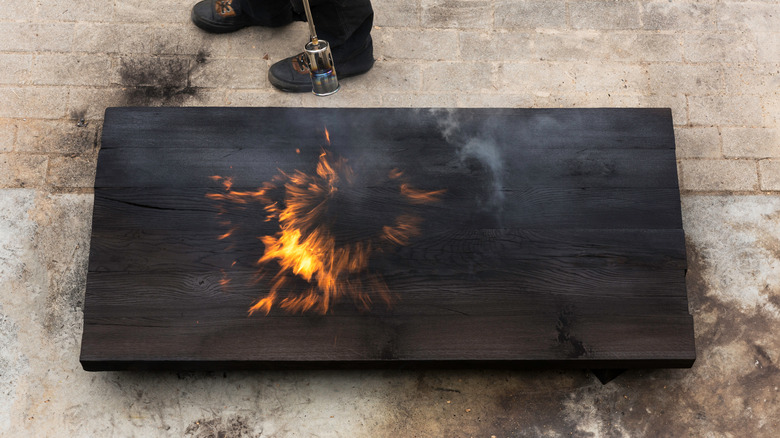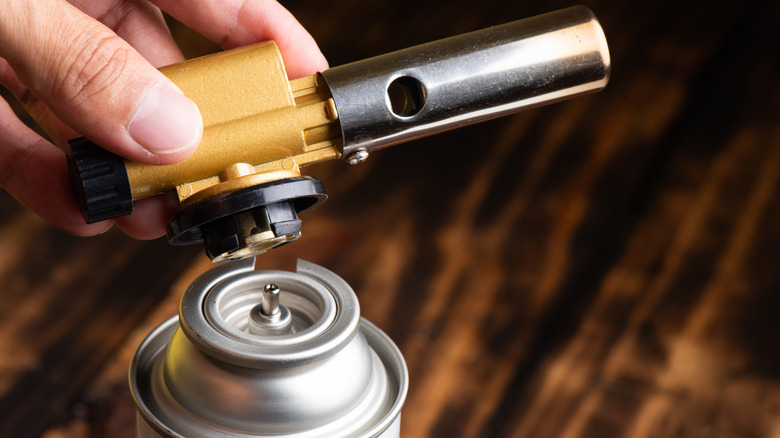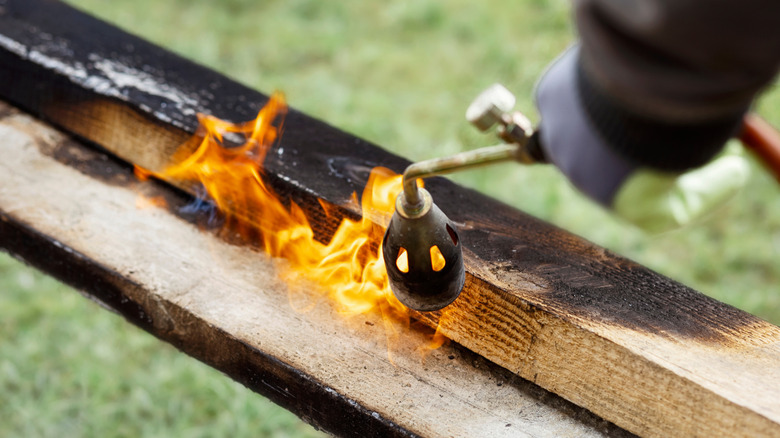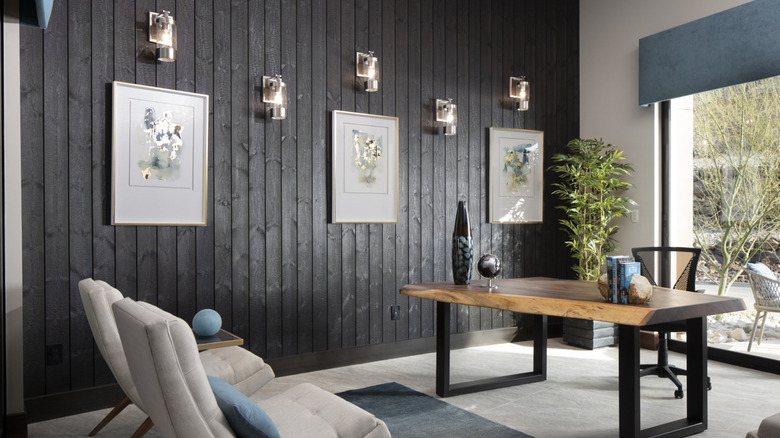Mistakes To Avoid When DIYing A Charred Wood Accent Wall
Keeping up with interior design trends can feel like an uphill battle, from the latest DIYs to the eclectic flooring that you should expect to see in 2025. There's one trend that seems to be taking interiors by storm — charred wooden accent walls, or Yakisugi. It introduce a bit of texture to break up sightlines, introducing a rich blackened wood finish that can make the perfect addition to any space. Yakisugi, the Japanese technique of burning wood to enhance its durability, gives the wood a stark deep color in the process. It has emerged as a means of introducing this much-needed texture to modern interiors, as opposed to paint. But before you attempt to replicate this stunning accent wall, let's break down everything you need to know about Yakisugi to ensure a successful application of the technique, including the main mistakes people make. With a number of variables involved in the process, it is important to avoid over-charring the wood for safety and durability and making sure to seal the wood to maintain its integrity.
What exactly is Yakisugi? Often referred to as Shou Sugi Ban, it involves charring wood to preserve it, creating a stunning, weathered look in the process. Originally used in Japan as a means of protecting wood from harsh elements and insects, the design choice is steeped in a rich tradition that can be traced back centuries. The charred exterior creates a natural barrier that transforms wood into a much more resistant material, from sun damage to termites, rotting, and water damage. In the contemporary era, the technique has found its way into interior design, adding a sense of elegance to modern interior spaces that is difficult to replicate.
Common mistakes when charring wood
As with most design trends that involves the use of an open flame, Shou Sugi Ban is as much about the proper technique as it is about aesthetics. While a controlled burn can transform ordinary wood into a beautifully textured surface, a misstep in the process can lead to disastrous results. One of the most common mistakes is over-charring the wood, which contributes to splintering and cracking. Excess heat, rather than reinforcing the wood, can have the opposite effect, weakening the structure of the wood. This can cause the wood to curl toward the heat and even crack under the intense heat. On the other hand, under-charring prevents the natural protective layer from forming on the surface of the wood. With the right technique, you can easily achieve the perfect balance from your charred wood but it might take a bit of practice with scrap wood.
Another frequently overlooked mistake is improper safety precautions. Charring wood releases a significant amount of smoke and airborne particles, which can be hazardous if inhaled. Working in an outdoor space with plenty of ventilation, as well as wearing protective gear can prevent any safety concerns from arising during the process. Additionally, many DIYers often miss a crucial step in the production of Yakisugi, sealing the wood. Applying a protective sealant helps maintain the finish and integrity of the charred surface over time. Without this step, the wood can be susceptible to flaking, discoloration, and exposure to moisture. Taking these precautions will ensure that the process of creating your charred wood accent wall is both safe and produces the desired effect.
Safely creating charred wood
To properly execute this technique, preparation is extremely important. Before reaching for your blow torch, you want to start by selecting the right type of wood for your Shou Sugi Ban. Cedar and cypress are traditionally used in this process as they can both withstand significant exposure to heat without excess warping or cracking. However, modern adaptations use a variety of hardwood and thermally modified softwoods, which offer different levels of durability, stability, and wood grains. If you're sourcing the wood for this project, you should be mindful of the fact that untreated wood may react differently to the heat, requiring more preparation.
Using a propane torch, move the flame steadily across the wood in even stroke, about 12 to 18 inches away from the surface of the wood. Try to avoid lingering over a specific spot for too long, as this can contribute to cupping from the wood. The goal is to create a uniform blackened finish with a slightly cracked surface. Flip each board over to ensure an even char across the entire surface of the wood. You can keep a bucket of water nearby to douse them when you are finished with the torch. Use a brush to scrub any excess soot and expose the rich grain beneath the surface. If you're using a transitional approach, applying a finishing oil can enhance the wood's durability and further bring out the rich color underneath. With these simple steps, you can curate a customized wooden accent wall that fits into any interior design style, ranging from modern to industrial, and rustic.
Incorporating charred wood into your decor
With your wood completely charred, it's time to install it around your space. The dramatic blackened wood serves as a natural focal point in any interior, offering a rich organic texture. In modern spaces, a Yakisugi accent wall brings a bit of warmth with the blackened wood without disrupting a minimalist aesthetic. Its varied wooden surface interacts with the light differently throughout the day, adding an interesting element of dimension to otherwise flatter spaces. Unlike painted black spaces, which can feel lifeless and flat, Shou Sugi Ban offers a dynamic feel that can enhance modern and rustic interiors.
A full floor-to-ceiling accent wall can make a bold pop for your space, especially in living rooms, bedrooms, and entryways. It can also serve as an anchor for certain interiors when paired with other black furniture like bookshelves. This allows you to curate a more cohesive look from your space without enveloping it in darker colors. Additionally, you can add a bit of contrast by using mixed metal accents, ranging from hardware to lighting fixtures. But Shou Sugi Ban doesn't need to just be an accent wall; it can make the perfect panelling for a wainscoting effect or the backdrop for open bookshelves. This more balanced approach helps to feature the rich tones without necessarily transforming an entire interior space. It also pairs well with other natural elements, like cooler stones, raw wood, and neutral textiles. With the right interior pairing, you can integrate the darker features of Shou Sugi Ban as an integral aspect of your interior design.



